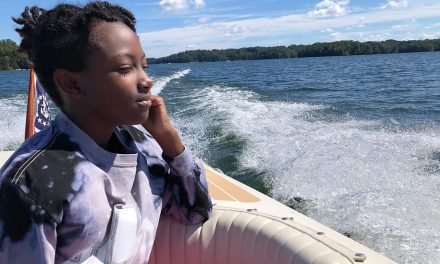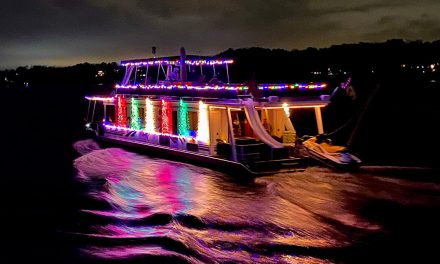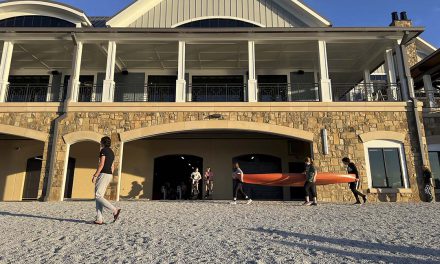In November, Lakeside’s Senior Reporter Pam Keene journeyed to Sicily and Southern Italy. In Part 2 of her travelogue, she shares her travels to unearth the charms of Southern Italy, some familiar, others surprising.
Halfway through our adventure to Sicily and Southern Italy, it was time to leave the charming seaside village of Pizzo – one of my favorite discoveries in Calabria in Southern Italy. From meeting Antonio and experiencing his colorful ceramics and paintings to saying goodbye to the amazing gelato invention “tartufo,” our group of 15 now head to parts unknown, heading inland.
The landscape slowly changed from craggy rocks and sandy shores to winding roads surrounded by forested hillsides as we entered the Sila National Park. We stayed in a hotel that provided accommodations unlike anywhere else we stayed.
Think upscale U.S. and national park lodges complemented by an expansive grotto/spa. The décor included large statues of bears and other wildlife, room signs with the numbers carved out of wood, and ultra-modern spacious rooms with stunning views. The chill in the night air encouraged sleeping with the windows open.
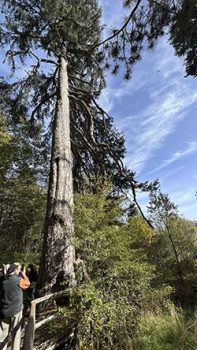
Giants of Sila – size compared to a human for reference.
Our trip leader Henna had hinted about the Giants of Sila, an ancient forest within the park, but we weren’t prepared for the sheer mass and height of these pines. Their vital statistics are posted on signs nearby; some of these 58 specimens are 150 feet tall and nearly 62 inches around.
Our 25-day itinerary was far more immersive than a typical tourist vacation. From a culinary and agricultural perspective, the activities were diverse. We toured several farms, including the capers farm on Salina in the Aeolian Islands. A family we met in the town of Martina Franca –Marianna and Franco – began to farm organically when their son proved to have many allergies to foods. As a result Franco now has four gigantic hoop houses where he cultivates tomatoes, peppers, and strawberries. He also has row crops such as kale, fresh lettuces, spinach and other foods. Our visit included lunch in the farmhouse to enjoy the fruits of his work.
As we moved into the Puglia region, food became even the focus of our travels. Visits to multiple farms and dairies kept our appetites on the edge. We learned how the region’s trademark capocollo dry-cured pork is created, seasoned and aged, followed by a lunch by the family’s restaurant where we were served about a half-dozen types of meats and sausages, including capocollo.
The secret of fresh mozzarella was revealed at a dairy where about 20 cows are milked daily to produce the heavenly soft cheese. The process is straightforward but the most interesting part is how our cheesemaker hand stretches the warm cheese to ensure the texture is authentic.
Wineries, too, introduced us to Primitivo wine, a deep red slightly tannic wine that’s similar to Zinfandel. We visited several wineries, going underground to the cool caves where it is aged in 60-gallon French oak. And of course, each winery visit included wine tastings and generous servings of antipasto, which in the U.S. we Americans have modernized into “charcuterie.”
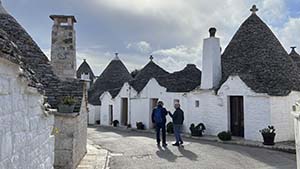
A typical street in a trulli village.
On to the trulli, the cone-shaped dry-stone houses with thatched roofs that began to dot the landscape. In Alberobello, we visited a 1.000-year-old trulli village of these handsome – and short – homes. Many today are rented to tourists, but we toured one and discovered that usually there are several of the buildings connected together to provide multi-room housing. Often the main room was a combination gathering place and bedroom, with a tall bed for the parents and sleeping nooks for the kids. In the winter, donkeys and other farm animals were brought inside to help with heating, and each trulli’s cistern provided drinking water.
The mountain town of Matera took us back centuries, when the people lived in caves across the nearby mountain range. It earned the name “shame of Italy” because the people were extraordinarily poor, living without electricity and water until the 1950s, when the government built proper houses and provided water and electricity. Today, the town is charming, and the standard of living has much improved; however, evidence of cave-dwelling remains, as does the town’s nickname.
As we headed north along the Adriatic coast, we stayed in a convent-turned-hotel in the harbor of the fishing village. Daily, fishermen would head out in a variety of crafts, coming back in the late afternoon with their catches of fish, crabs, langostino – our version of shrimp but with the heads on – plus eel, octopus and other deep-sea delicacies.
The seafood in Trani is always fresh, and fishermen are greeted by restaurateurs and individuals alike who are eager to cook up the latest harvest from the sea.
Some of us visited the town’s historic Jewish Quarter and learned about the struggles the people endured over the centuries.
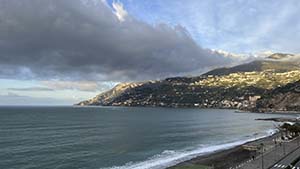
Cloud formations over the Amalfi Coast didn’t always accurately predict the weather for the day.
Rick and I chose to take the Overseas Adventure Travel post-trip to the Amalfi Coast on the Tyrrhenian Sea, just south of Naples. On the way, we visited the ruins at Venosa in the Basilicata region. Ancient Roman ruins from the third century BC gave way to a medieval church that was replaced by an eleventh-century church that was never completed.
We settled in Maiori on the south end of the Amalfi Coast, which served as our home base for several days. Each day, we explored the towns along the coast including the posh and very popular Positano, known for its lemon trees that cover the hillside. Thank goodness we were there at the very end of the vacation season. Our trip leader Cristiano told us that at the height of the summer, it’s impossible to navigate the narrow streets or find a place to relax on the wide beaches.
A change in our itinerary brought a special visit to Pompeii, once a thriving Roman town that was annihilated in 79 AD by the eruption of nearby Mount Vesuvius. Buried under nearly 20 feet of volcanic ash and pumice, the 170-acre site in the Campania region has been partially excavated and restored.

Pompeii’s ruins towered over a stone street.
I first visited Pompeii in 2000 and, after reading about it in National Geographic, where it was a cover story when I was a teenager. I was stunned by the condition of the streets, remaining walls of houses and public structures and ruins of a major Roman city first built in the 7th and 6th centuries BC. Back then, well-worn tracks of carriage wheels etched into the stone streets marked the most popular passages in town, but as I remember, much of the site was rather uninteresting.
This time, more than 20 years later, further restoration and archeological exploration has revealed more of the city’s infrastructure as well as colorful frescos, several additional residences and sadly at least 1,000 more bodies, preserved for more than 2,000 years. Work to stabilize the site, as well as further excavation, continues. For me, what a treat to be able to make a comparison 20 years after my first visit.
We spent our final 2-day stay in Sorrento, one of the most-visited places on the Amalfi Coast at the height of the summer. It was relatively quiet as the travel season wound down in mid-November. Its main street, for pedestrians only, was barely crowded, allowing for comfortable strolls and minimal wait times at restaurants.
Tourists mostly visit the upper part of the town, but I ventured off-book and spent a couple of hours on the shore of the lower fishing village. Conversations with families who live there, and with multiple generations of fishermen, gave me a different view of this part of the Amalfi Coast where life is routine, and the people are friendly and welcoming.
Twenty-five days can be a long time to be away from home, but every time I travel I am grateful for every minute of adventure and exploration. This trip to Sicily and Southern Italy – the overlooked part of the country shaped like a boot – introduced me to the other side of life in one of the most-visited countries in the world.
Photos: by Pamela A. Keene

